Answered step by step
Verified Expert Solution
Question
1 Approved Answer
Question 2 Bath Co. is a company specializing in the manufacture and sale of baths. Each bath consists of a main unit plus a set

Question 2 Bath Co. is a company specializing in the manufacture and sale of baths. Each bath consists of a main unit plus a set of bath fittings. The company is split into two divisions, A and B. Division A manufactures the bath and Division B manufactures sets of bath fittings, Currently, all of Division A's sales are made externally. Division B, however, sells to Division A as well as to external customers. Both of the divisions are profit centres. The following data are available for both divisions: Division A Costs per bath: Fittings from Division B Other materials from external suppliers Labour costs Annual fixed overheads Annual production and sales of baths (units) Maximum annual market demand for baths (units) Current external selling price per set of fittings Current price for sales to Division A Costs per set of fittings: Materials Labour costs Annual fixed overheads Maximum annual production and sales of sets of fittings (units) (including internal and external sales) Maximum annual external demand for sets of fittings (units) Maximum annual internal demand for sets of fittings (units) $75 $200 $45 $7 440 000 80 000 80 000 $80 $75 $5 $15 $4 400 000 200 000 180 000 80 000 The transfer price charged by Division B to Division A was negotiated some years ago between the previous divisional managers, who have now both been replaced by new managers. Head office only allows Division A to purchase its fittings from Division B, although the new manager of Division A believes that he could obtain fittings of the same quality and appearance for $65 per set, if he were given autonomy to purchase from outside the company. Division B makes no cost savings from supplying internally to Division A rather than selling externally. Required: (a) (b) Under the current transfer pricing system, prepare a profit statement showing the profit for each of the divisions and for Bath Co. as a whole. Your sales and costs figures should be split into external sales and interdivisional transfers, where appropriate. Head office is considering changing the transfer pricing policy to ensure maximization of company profits without demotivating either of the divisional managers. Division A will be given autonomy to buy from external suppliers and Division B to supply external customers in priority to supplying to Division A. Calculate the maximum profit that could be earned by Bath Co. if transfer pricing is optimized. Discuss the issues of encouraging divisional managers to take decisions in the interests of the company as a whole, where transfer pricing is used. Provide a reasoned recommendation of a policy Bath Co. should adopt. (c) Question 2 Bath Co. is a company specializing in the manufacture and sale of baths. Each bath consists of a main unit plus a set of bath fittings. The company is split into two divisions, A and B. Division A manufactures the bath and Division B manufactures sets of bath fittings, Currently, all of Division A's sales are made externally. Division B, however, sells to Division A as well as to external customers. Both of the divisions are profit centres. The following data are available for both divisions: Division A Costs per bath: Fittings from Division B Other materials from external suppliers Labour costs Annual fixed overheads Annual production and sales of baths (units) Maximum annual market demand for baths (units) Current external selling price per set of fittings Current price for sales to Division A Costs per set of fittings: Materials Labour costs Annual fixed overheads Maximum annual production and sales of sets of fittings (units) (including internal and external sales) Maximum annual external demand for sets of fittings (units) Maximum annual internal demand for sets of fittings (units) $75 $200 $45 $7 440 000 80 000 80 000 $80 $75 $5 $15 $4 400 000 200 000 180 000 80 000 The transfer price charged by Division B to Division A was negotiated some years ago between the previous divisional managers, who have now both been replaced by new managers. Head office only allows Division A to purchase its fittings from Division B, although the new manager of Division A believes that he could obtain fittings of the same quality and appearance for $65 per set, if he were given autonomy to purchase from outside the company. Division B makes no cost savings from supplying internally to Division A rather than selling externally. Required: (a) (b) Under the current transfer pricing system, prepare a profit statement showing the profit for each of the divisions and for Bath Co. as a whole. Your sales and costs figures should be split into external sales and interdivisional transfers, where appropriate. Head office is considering changing the transfer pricing policy to ensure maximization of company profits without demotivating either of the divisional managers. Division A will be given autonomy to buy from external suppliers and Division B to supply external customers in priority to supplying to Division A. Calculate the maximum profit that could be earned by Bath Co. if transfer pricing is optimized. Discuss the issues of encouraging divisional managers to take decisions in the interests of the company as a whole, where transfer pricing is used. Provide a reasoned recommendation of a policy Bath Co. should adopt. (c)
Step by Step Solution
There are 3 Steps involved in it
Step: 1

Get Instant Access to Expert-Tailored Solutions
See step-by-step solutions with expert insights and AI powered tools for academic success
Step: 2

Step: 3

Ace Your Homework with AI
Get the answers you need in no time with our AI-driven, step-by-step assistance
Get Started


